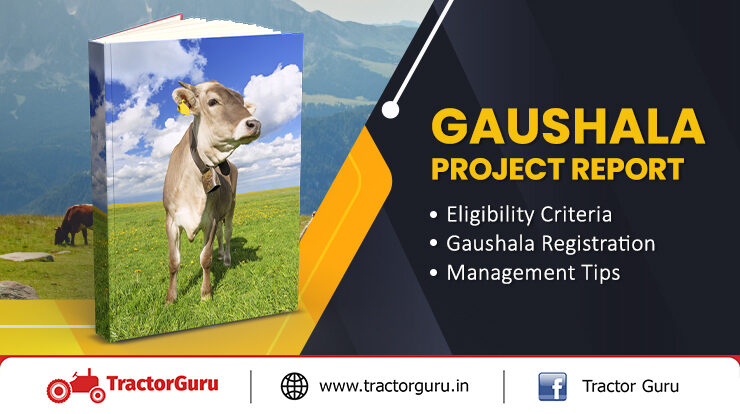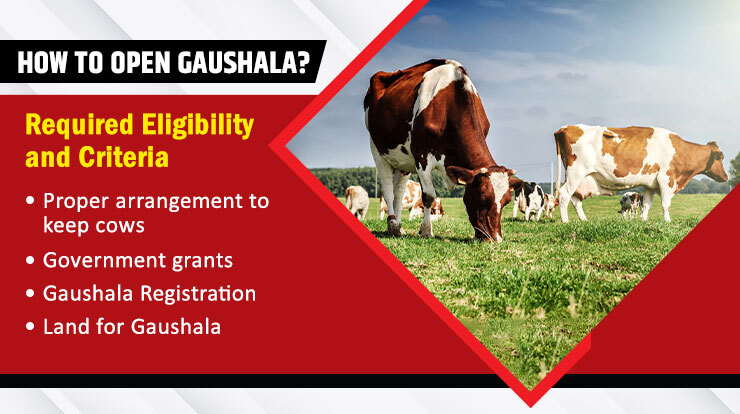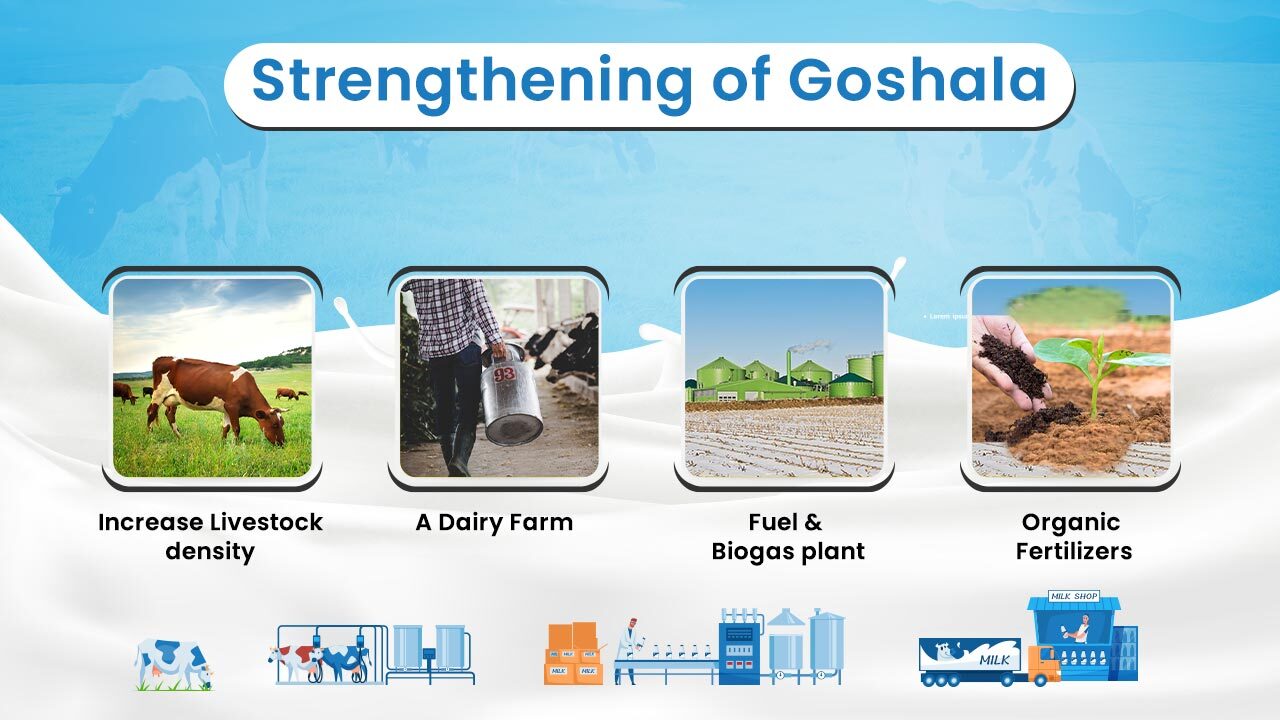Gaushala Registration Process – Gaushala Project Report

Goshala is a Sanskrit word which derives from (“Gau” means cow, and “Shala”, means a sheltered place: Go + Shala = Goshala/Gaushala, a shelter for cows). A place of abode or shelter for cows, oxen and calves. It is a protective shelter for abandoned or stray cows where they get the proper assistance to be nurtured. Although Gaushala project gets so many grants or sanctions from the government, yet donations are a primary source of income for them.
Gaushala basically assists cows, calves, buffaloes and oxen and focuses on their health and keeping disease free. Because of religious importance, cows must be welfared.
The Methodology says; People across India today want to bring an end to cow slaughter. A cow is a holy adobe of our 33 types of Gods & by serving the cow, and we somehow serve them. The word “Gau” has 4 meanings: Jnaana (knowledge), Gaman (to Progress), Praapti (to receive) and Moksha (liberation). A cow provides all four of these. And all the products a cow gives us help us move ahead in our day-to-day lives. So, we must pay attention to this and honour the cow.
“Serving, worshipping cows and taking care of cows is our Dharma, then our own protection is guaranteed”, Krishna said.
How do we help Gaushalas?
Fortunately, we can also help Gaushala in many different ways, like by money donations, donating fodder, and there are so many ways by which we can assist them to improve and enhance. India is the world’s top country that has a number of cattle, including cows, calves, oxen, buffaloes etc.
Well, there are more than 5k Gaushalas in India, and more than 6 lakhs cattle are housed in them. The biggest Gaushala in India is Gopal Govardhan Gaushala which is situated in Pathmeda village near Sanchore, Rajasthan. This Goshala is spread over 200 acres area, which is 0.81 km2 and nurtures more than 18,000 cattle.
So, be a cause of good task, religious or spirituality and start a gaushala project. Here we will tell you how to start gaushala project with gaushala registration, investment and management tips.
How to Open Gaushala? – Essential Guidelines

Required eligibility and criteria to open Gaushala:- A campaign run by the Government of Rajasthan, under which any farmer can apply for Gaushala. But proper care of cows will be given priority by the government.
- To open a gaushala, the gaushala custodian should have a proper arrangement to keep 200 cows.
- The officials will do necessary checks to ensure that the amount of grant received by the government is available in the form of fodder water to the cows on time.
- Pre-inspection of the proper arrangement of cows will be done with Gaushala Patron.
- A grant of Rs 50 per cow and Rs 25 for a calf will be given to the guardian of the Gaushala on a daily basis.
- To open a Gaushala, one must apply for Gaushala registration by taking an application form from the Office of the Chief Veterinary Officer located at Vikas Bhawan.
- Land for gaushala – To effectively run a goshala with 500 to 1000 cattle, minimum of 1.5 to 2-acre land is required. Likewise, to run a gaushala business with 2500 to 5000 cattle, a minimum of 5 to 10-acre land is required.
Registration of Gaushala

There are 2 options to apply for Gaushala Yojana Registration: by web portal or by Common Service Centre (CSC). Below is the application process to apply for the complete gaushala registration process; then, you can start your gaushala project.
1. Firstly, visit the official state gaushala online registration system portal
2. Click on the Registration link
3. Fill gaushala registration form 2022
- Enter the required details on the application form carefully, such as (goshala name, establishment date, district, applicant name, father’s name, username, e-mail, password etc.).
- Attach required documents regarding gaushala project
4. After that, submit the application form, your online registration number will be allotted through the portal. Then your application will be submitted successfully.
Major Challenges for Goshala
There are some major chronic challenges that gaushala oftenly faces. Below we have mentioned some:
- Paucity of funds
- Insufficient financial aid from governments
- Inadequate fodder availability
- Inadequate access to technical services
- Poor infrastructure facilities
- Poor management
Strengthening of Goshala

There are many sustainable ideas and benefits of gaushala, which you can start from cow products with less investment.
- Increase Livestock density
- A Dairy Farm
- Fuel & Biogas plant
- Organic Fertilizers
Government Schemes for Gaushala
If you are planning a gaushala project report and have already made a gaushala business plan, but the cost stops you from initiating it. The government will assure you with financial assistance and subsidy on gaushala project report. So, check the following government schemes, which are initiated by the government & that will help you to open your certified and register Gaushala.
1. Gaushala Anudan Sahayta
In this campaign to provide cow protection, grants will also be given through the government to those opening cow shelters for cow protection. Any farmer in India can open a cowshed, and they should have the facility to keep about 200 cows, according to Animal Husbandry Minister SP Singh Baghel. So the government will also provide you with a grant for the protection of each cow.
2. District Level Nandishala Jan Sahayak Yojana
The motive of this Yojna is to be opened Nandi gaushala in every district for stray or abandoned oxen/male cows. So, for this purpose, the Nandishala Jan Sahayak Yojana has also started where there is a rule of giving funds Rs. 50 Lakhs for construction and maintenance. A part of this provision of assistance has been made for 06 months in a year to maintain Nandi’s residing in Nandi Gaushala.
3. Gaushala Vikas Yojana
In this government scheme, the government supports infrastructure development in the state-registered Gaushala. It is a separate scheme that the state government must approve to provide financial and infrastructural assistance also. But some norms must be fulfilled, according to the state government, which includes at least 100 Gauvansh are must be maintained. Under this scheme, a government-sanctioned maximum of Rs. 10 Lakh for the Gaushala construction work but a 10% contribution will be contributed by Gaushalas.
The government permitted infrastructure work under the scheme:-
- Shed Construction
- Fodder Storage
- Water Kheli Construction
- Fodder Thaan Storage
- Water Tank Construction
- Construction of Stilts inside the Shed (of stacked bricks)
- Construction of Gopalak House
4. Vadh Se Bachaye Gauvansh
The upbringing of the cattle saved from slaughter has now come under the purview of the rules. The state government has given orders to the Directorate of Gopalan to provide assistance to the cowsheds by amending the Act but has also given the task to the police that it will monitor from FIR till their upbringing. In many cowsheds, the police release the rescued cows from slaughter. But in the absence of proper action, the gaushala operators yearn for assistance for the maintenance of the cows. Such cows will be handed over to the cowsheds.
5. Bio Gas Jan-Sehbhagita Yojana
Under this scheme, the state government provided financial assistance to construct Bio Gas plants to create a non-conventional source of energy. This will significantly increase Gaushala’s income and make itself self-reliant on energy and electricity also by producing Biogas. In addition, the plan will sanction for those Gaushalas which are operating on 25 Bigha land or more than that.
6. Bhrun Pratyaropan Yojana
The plan to implant the embryo of good cows in the womb of other cows will now move out of the research centre and reach the farmers and livestock farmers. The Central Research Institute is preparing a plan to take this program on the ground. For the last two years, the scientists of the institute, who have been involved in the embryo transplant process, have improved this work more than before.
Scientists and officials of the institute say that the results of embryo transplantation have also been better. With this, the officials, along with the state government, are planning to take it to the farmers and livestock farmers also of the state.
7. Panchayat Samiti Level Nandishala Jan Sahbhagita Yojana
Through this scheme, Nandishala will be open at every Panchayat Samiti Level to provide shelter and solve the problems also of abandoned and stray cattle. Under the government observation and Gaushala operators, in this Nandishala, bull, ox, cows, calves and buffaloes also will be nurtured. So, that’s why many gaushalas will be opened at every Panchayat Samiti.
Gaushala Management Tips
You should set standard practices for managing Gaushala that adequately addresses the overall welfare needs of the cattle housed in. The following management tips in Gaushalas lay down basic minimums for their housing, husbandry and overall management.
-
Daily Routines of Gaushala
In Gaushalas, most animals who live there are abandoned/rescued/unproductive or abused too. These kinds of cattle need extra pampering or special care like they require a good and balanced diet twice a day. You should serve them fresh green fodder in the morning and evening also. This routine will also keep them healthy to some extent.
Here is a suggested time and season to keep the cattle accordingly,
| Particular | In Summer | In Winter |
| You should allow the cattle to stay out in the open at night due to warm sheds. | You must keep the cattle inside the sheds during the night. | |
| Feeding | ||
| Morning | At 6 am, inside the shed | At 7 am, outside the shed |
| Evening | At 4 PM, outside the shed | At 5 PM, inside the shed |
| Pick Cow Dung | In between 8 AM to 10 AM | In between 9 AM to 11 Am |
| Cleaning from Outside | In between 8 AM to 10 AM | In between 5 PM to 7 PM |
| Cleaning of Sheds | In between 5 PM to 7 PM | In between 9 AM to 11 Am |
| Fresh Water | Must be available inside & outside the shed | Must be available inside & outside the shed |
-
Feeding
To feed cattle properly, you must have grazing land, which has to be planted with vegetation. Along with this, animals should have unrestricted access to clean water or grazing anywhere in space. If you do not have a large area to graze them, so you can put a feeding manger and also a water trough for cattle.
Choose feeding manger and water trough according to the cattle.
| Type of Cattle | Feeding manger for per animal (cm) | Water trough /animal (cm) |
| Newborn calves (Less than 8 weeks) | 40-50 cm | 10-15 cm |
| Older calves (More than 8 weeks) | 40-50 cm | 10-15 cm |
| Heifers | 40-60 cm | 30-45 cm |
| Adult Cows | 60-75 cm | 45-60 cm |
| Adult Buffaloes | 60-75 cm | 60-75 cm |
| Down Calvers | 60-75 cm | 60-75 cm |
| Bulls | 60-75 cm | 60-75 cm |
| Bullocks | 60-75 cm | 60-75 cm |
-
Housing & Environment
Animals should be kept in small and stable groups and provided them with a natural behaviour where they can roam freely, grazing and feeding their calves also. Along with that, provide a better and more comfortable flooring where they can relax. Or, if you have a cubicle to keep the cattle, it must be spacious enough for them to stand up and lie down easily.
Make a floor that should not be too slippery, hard or rough for your cattle. You should choose a comfortable floor to sit them there, instead of stony or concrete floors because that may harm their hooves also.
The minimum floor should be for animals;
| Type of Cattle | Floor Space /animal (mt square) | |
| Covered area | Open area | |
| Young Calves (less than 8 weeks) | 1.0 mt square | 2.0 mt square |
| Older Calves (More than 8 weeks) | 2.0 mt square | 4.0 mt square |
| Heifers | 2.0 mt square | 4.0-5.0 mt square |
| Adult Buffaloes | 4.0 mt square | 8.0 mt square |
| Adult Cows | 3.5 mt square | 7 mt square |
| Cows with Calvings | 12.0 mt square | 20-25 mt square |
| Bulls | 12.0 mt square | 120.0 mt square |
| Bullocks | 3.5 mt square | 7.0 mt square |
-
Milking
If you are milking manually (by hand), so it should be done by the “full hand” method, or you can use milking equipment. Milking machines must be hygienic while milking, and you also have a good practice of using that machine; otherwise, it may harm the animal also.
-
Health Care
The cattle herd scrutiny should appropriately happen also every day. Sick animals should be housed separately in another shed with a proper stock of water and fodder. Caretakers should also be trained and in enough to ensure good care.
Regular vaccination and parasite control programmes also should be in place against prevalent bovine diseases. You have to keep in your mind that your cattle should also be vaccinated against foot and mouth diseases, and after 90 days of birth, every animal should be vaccinated against rabies.
-
Record keeping
You have the complete record of every cattle when they come there and go out. With all these things, you must have their death and birth details also with their certificate. The following register and records Gaushala must have their bookkeeping also.
- Stock registers for dry & green fodder
- Expendable and miscellaneous registers
- Donation receipt records
- Log books for transport and other P&L.
Note: This information regarding the Gaushala project is for learning and knowledge purposes also. The figures and methods of the Gaushala project may change over time.
FAQs
Que. Which government scheme will assist us for Gaushala infrastructure?
Ans. The Gaushala Vikas Yojana will assist you for Gaushala infrastructure.
Que. What are the sustainable benefits of opening a Gaushala?
Ans. There are many benefits of opening a Gaushala, like a dairy farm, biogas plant etc.
Que. How much land is required for 500-1000 cattle for Goshala?
Ans. A minimum of 1.5 to 2-acre land is required for 500-1000 cattle for Goshala.



